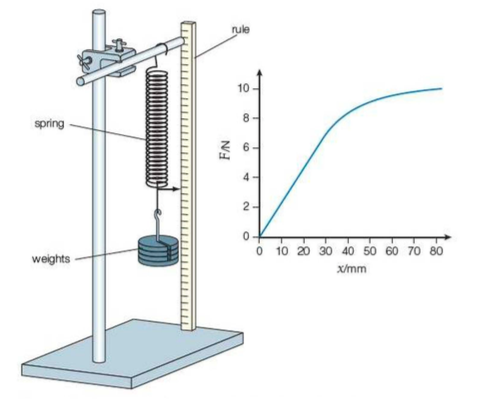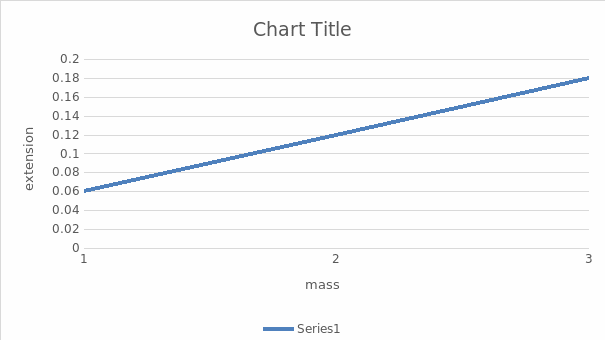Introduction
When a string or an elastic material is pulled, it extends in proportion to the force exerted until the elastic limit is exceeded. In response to the pulling force, a restoring force is equal to the compression or extension force. The direction of force, that is, compression or stretching force determines the sign on the equation.

In essence, the restoring force is equal and in opposite direction to the force exerted on the elastic material.
- F=kx- (i)
- F=-kx- (ii)
The first equation represents extension/stretching, while the second equation represents compression. These equations are only valid for as long as the force exerted does not exceed the material’s elastic limit (Mazur, 2014). In the equations above, F represents the force exerted, k is the spring constant given in N/M, and x is the extension or compression given by the difference between the new and original lengths of the material.
Objectives
- To experimentally determine the relationship between the force exerted on a spring and the extension or compression produced.
- To determine the spring constant from graphical data.
Materials
Preliminary Set Up and Questions
Different elastic materials have different spring constants, implying that they react differently to forces exerted on them. Again, one may not easily tell the value of a material’s spring constant since many are not labeled. For this reason, an experiment on Hooke’s law enables one to generate mass vs. extension/compression change and plot a graph. The graph’s slope can then be calculated to give the spring constant. The three main elements studied in this experiment are mass, force, spring constant, and extension.
Procedure
- Hang the spring on a vertical plane.
- Measure its initial length.
- Hang one mass.
- Record the new length.
- Calculate the difference between the initial and new lengths.
- Repeat the procedure with different masses while recording the new lengths.
- Record the extension by subtracting the new length from the initial in each measurement.
- Plot a graph of the extension, x, versus the mass.
- Calculate the spring constant from the slope of the graph.
Data Tables

Analysis
The data collected and the graph above show a linear relationship between the mass and the extension. Three different masses were used: 0.07. 0.1, and 0.5 Kg and the relative extensions measured. The straight line shows a linear relationship implying that the spring constant was not exceeded, that is, the masses were lighter than that required to completely cause a deformation. The spring constant is calculated as the slope of the graph as shown below:
- F=kx
- F=mg
In this experiment, the gravitational acceleration, g was used as 10 N/Kg
From the above equation, the spring constant can be derived from the equation for force.
- K=df/dx
- K=10. (0.2-0.1)/(0.06-0.12)=0.1/0.-06= -1.667
The spring constant k=1.667N/m2
Since the value is a constant for a particular spring, it has no negative values. In the first two trials, different masses were used to show the variation between mass and extension. The third trial was used as a control experiment in which the same mass was used twice to show that no change in extension would occur unless an extra weight was added. In essence, although one experiment would give sufficient results, the three trials were important to confirm the application of Hooke’s law. In the above equation, the gravitational acceleration was a constant value of 10N/Kg. For this reason, the varying factors were only the mass and extension.
Conclusion
Hooke’s law is one of the fundamental principles in physics that defines the relationship between mass exerted and the extension/compression of an elastic material. Mass is the quantity of matter in an object, given in Kg. Every free object is acted on by the gravitational force of acceleration, giving its weight. According to Hooke’s law, whenever weight is exerted on a vertically hanging spring, it extends. The extension is directly proportional to the force exerted, in the case of a pulling force. If a compression force is used, then the spring shrinks in size in a measure proportional to the force. The direction of the restoring force is always opposite to the force acting on the spring. In this experiment, three different masses were used in three trials, and the data was recorded for graphical representation. The graph shows a linear relationship between mass and extension, with its slope giving the spring’s constant.
Appendixes
Basic definitions
Hooke’s law
A law that states that extension is directly proportional to the applied force
Mass
Quantity of matter
Extension
The difference in the length after application of weight on a spring
Equations
- F=kx
- K=df/dx
- F=force exerted on the spring, K=spring constant, x= the extension
Reference
Mazur, E. (2014). Principles and practice of physics. Addison-Wesley Professional.